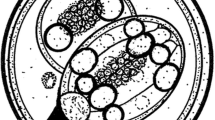Abstract
Coccidian oöcysts recovered from the faeces of rough earth snakes Virginia striatula (Serpentes: Colubridae) were found to represent two previously unreported eimerians. Oöcysts of Eimeria desotoensis n. sp. were found in 5/32 (16%) of the snakes and were spherical to ellipsoidal, 18.4 × 17.2 (15–21.5 × 15–19.5) μm, with a thin, single-layered wall; their shape-index (length/width) was 1.07 (1.00–1.23). A micropyle and oöcyst residuum were absent; polar granule were present in 33% of the oöcysts. The sporocysts were ovoidal, 11.5 × 7.6 (10.5–13 × 7–8) μm, with a Stieda body; their shape-index was 1.51 (1.30–1.68). The sporocyst residuum was moderate in size and composed of a cluster of granules. Oöcysts of Eimeria hobartsmithi n. sp. were found in 2/32 (6%) of the snakes and were subspherical to ellipsoidal, 18.0 × 15.7 (16–20 × 15–17) μm, with a thin, single-layered wall; their shape-index was 1.15 (1.02–1.32). A micropyle, oöcyst residuum and polar granule were absent. The sporocysts were elongate, 13.2 × 6.3 (12–14.5 × 6–6.5) μm, with a Stieda body; their shape-index was 2.10 (1.88–2.34). A large sporocyst residuum was present in each sporocyst, often obscuring the sporozoites. In addition to the two new species, oöcysts of E. striatula Upton & McAllister, 1990 were observed in 38% of the snakes.
Similar content being viewed by others
References
Carini, A. (1933) Sur quelques Eimeria recontrées dans l'intestin de serpents non venimeux du Bresil. Annales de Parasitologie Humaine et Comparée, 11, 472–475.
Carini, A. (1934) Sobre algumas Eimerias encontradas no intestino de cobras nao venenosas do Brasil. Arquivos de Biologia (São Paulo), 18, 10–12.
Conant, R. & Collins, J.T. (1991) A field guide to reptiles and amphibians of eastern and central North America (3rd edition). Boston: Houghton Mifflin, 450 pp.
Lainson, R. & Shaw, J.J. (1973) Coccidia of Brazilian snakes: Isospora decipiens, Eimeria micruri, E. leimadophi spp. n., with redescriptions of Caryospora brasiliensis Carini, 1932 and Eimeria poecilogyri Carini, 1933. Journal of Protozoology, 20, 358–362.
McAllister, C.T. & Upton, S.J. (1989) Coccidian parasites (Apicomplexa: Eimeriidae) of Nerodia spp. (Serpentes: Colubridae), with a description of a new species of Eimeria. Journal of Protozoology, 36, 271–274.
Upton, S.J. & McAllister, C.T. (1990) The Eimeria (Apicomplexa: Eimeriidae) of serpentes, with descriptions of three new species from colubrid snakes. Canadian Journal of Zoology, 68, 855–864.
Wacha, R.S. & Christiansen, J.L. (1974) Systematics of the eimerian parasites from North American snakes of the family Colubridae, and their prevalence in the colubrids of Iowa. Journal of Protozoology, 21, 483–489.
Wacha, R.S. & Christiansen, J.L. (1975) Two new species of Eimeria from colubrid snakes in Iowa. Journal of Protozoology, 22, 453–454.
Author information
Authors and Affiliations
Rights and permissions
About this article
Cite this article
Upton, S.J., McAllister, C.T. & Trauth, S.E. Description of the oöcysts of two new species of Eimeria (Apicomplexa: Eimeriidae) from the rough earth snake Virginia striatula (Serpentes: Colubridae) in Texas and Arkansas. Syst Parasitol 23, 51–54 (1992). https://doi.org/10.1007/BF00008009
Accepted:
Issue Date:
DOI: https://doi.org/10.1007/BF00008009




